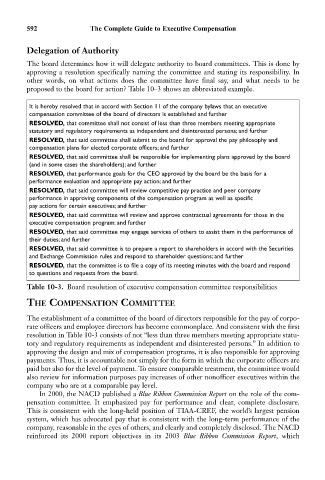Page 606 - Bruce Ellig - The Complete Guide to Executive Compensation (2007)
P. 606
592 The Complete Guide to Executive Compensation
Delegation of Authority
The board determines how it will delegate authority to board committees. This is done by
approving a resolution specifically naming the committee and stating its responsibility. In
other words, on what actions does the committee have final say, and what needs to be
proposed to the board for action? Table 10–3 shows an abbreviated example.
It is hereby resolved that in accord with Section 11 of the company bylaws that an executive
compensation committee of the board of directors is established and further
RESOLVED, that committee shall not consist of less than three members meeting appropriate
statutory and regulatory requirements as independent and disinterested persons; and further
RESOLVED, that said committee shall submit to the board for approval the pay philosophy and
compensation plans for elected corporate officers; and further
RESOLVED, that said committee shall be responsible for implementing plans approved by the board
(and in some cases the shareholders); and further
RESOLVED, that performance goals for the CEO approved by the board be the basis for a
performance evaluation and appropriate pay action; and further
RESOLVED, that said committee will review competitive pay practice and peer company
performance in approving components of the compensation program as well as specific
pay actions for certain executives; and further
RESOLVED, that said committee will review and approve contractual agreements for those in the
executive compensation program; and further
RESOLVED, that said committee may engage services of others to assist them in the performance of
their duties; and further
RESOLVED, that said committee is to prepare a report to shareholders in accord with the Securities
and Exchange Commission rules and respond to shareholder questions; and further
RESOLVED, that the committee is to file a copy of its meeting minutes with the board and respond
to questions and requests from the board.
Table 10-3. Board resolution of executive compensation committee responsibilities
THE COMPENSATION COMMITTEE
The establishment of a committee of the board of directors responsible for the pay of corpo-
rate officers and employee directors has become commonplace. And consistent with the first
resolution in Table 10-3 consists of not “less than three members meeting appropriate statu-
tory and regulatory requirements as independent and disinterested persons.” In addition to
approving the design and mix of compensation programs, it is also responsible for approving
payments. Thus, it is accountable not simply for the form in which the corporate officers are
paid but also for the level of payment. To ensure comparable treatment, the committee would
also review for information purposes pay increases of other nonofficer executives within the
company who are at a comparable pay level.
In 2000, the NACD published a Blue Ribbon Commission Report on the role of the com-
pensation committee. It emphasized pay for performance and clear, complete disclosure.
This is consistent with the long-held position of TIAA-CREF, the world’s largest pension
system, which has advocated pay that is consistent with the long-term performance of the
company, reasonable in the eyes of others, and clearly and completely disclosed. The NACD
reinforced its 2000 report objectives in its 2003 Blue Ribbon Commission Report, which

